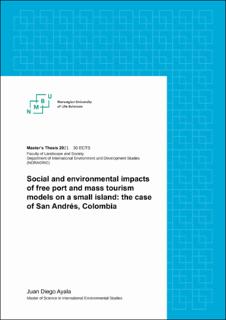| dc.description.abstract | Tourism-driven development economic models have shaped the Caribbean region since the 1950s, generating major transformations as a result of the implementation of neo-liberal approaches to the territories. The archipelago of San Andrés, Providencia y Santa Catalina, has not been an exception to these phenomena. In particular, San Andrés Island has experienced a process of Colombianization, imposed economic development models, and population growth with serious implications for the local communities and the environment. This study investigated how the free port and mass tourism models for economic development have influenced the socio-economic realities of the island’s inhabitants and impacted the environmental conditions of San Andrés. 63 semi-structured interviews and extensive field observations were conducted. The study explored concepts of overpopulation and resource scarcity, neo-liberalism, neo-colonialism, land grabbing, and marginalization to illuminate the different roles of tourism and resident communities in relation to urbanization, infrastructure systems, population growth, and changes in landscape and land tenure. Large-scale changes have occurred in San Andrés in the last 60 years as a result of the implementation of the free port and mass tourism models. Major infrastructure projects, extensive urbanization and tourism infrastructure, and migration-driven population growth have caused substantial environmental degradation across the island. Events of land grabbing and displacements, unequal opportunities of access to drinking water, in combination with unsustainable tourism practices which generate significant pressure on the island’s resources and ecosystems and trigger conflicts with local inhabitants, have determined the marginalization of part of the Raizal and Continental societies. The economic dependence on tourism portrays a scenario of increasing vulnerability for excluded islanders that have abandoned traditional livelihoods to seek for a better future by joining tourism activities, becoming entirely dependent on the ever-growing tourism. The Colombianization of San Andrés, the free port and the mass tourism model are clear examples of neo-colonial approaches to a territory that shift the power from the local level to transfer it to external, more powerful actors. In an island that depends on the revenues generated by tourism, the uncertainty of the future due to climate change and global processes, require new forms of tourism, territorial planning, and diversification of livelihoods, which should give local communities of San Andrés adequate frameworks and tools to face future changes. | en_US |

